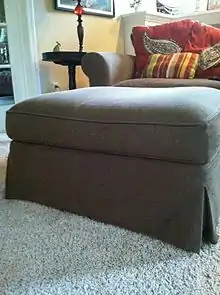Ottoman (furniture)
An ottoman is a piece of furniture.[1] Generally ottomans have neither backs nor arms. They may be an upholstered low couch or a smaller cushioned seat used as a table, stool or footstool. The seat may have hinges and form a lid for the inside hollow, which can be used for storage of linen, magazines or other items, making it a form of storage furniture.[2][3] The smaller version is usually placed near to an armchair or sofa as part of living room decor or may be used as a fireside seat.[4]

Ottoman footstools are often sold as coordinating furniture with armchairs, sofas or gliders. Other names for this piece of furniture include footstool,[5] hassock,[6] pouf (sometimes spelled pouffe),[7][8] in Shropshire, England the old dialect word tumpty[9] may be used, or in Newfoundland a humpty.[10]
History
The ottoman traces its roots to furnishing practices in the Ottoman Empire, where it was the central piece of residential seating, generally designed as a low wooden platform intended to be piled with cushions. It was first designed as sectional furniture that wrapped around three walls of a room, before evolving into smaller versions that fit into the corner of a room[11] or circular padded seats surrounding a column or pole in a public room.
The ottoman was eventually brought to Europe from the Ottoman Empire in the late 18th century and named after its place of origin. The earliest known instance of the use of the name is ottomane in French in 1729,[12] and in the course of a generation it made its way into every boudoir, but it appears originally to have been much larger than at present.
The first known recorded use in English occurs in one of Thomas Jefferson's memorandum books from 1789: "P[ai]d. for an Ottomane of velours d'Utrecht."[13] Over time, European ottomans took on a circular or octagonal shape through the 19th century, with seating divided in the center by arms or by a central, padded column that might hold a plant or statue. The ottoman began to have hinged seats to make use of the empty space inside which can be used to store items.
The ottoman footstool, a closely allied piece of furniture, was an upholstered footstool on four legs, which could also be used as a fireside seat, the seat covered with carpet, embroidery or beadwork. By the 20th century the word ottoman had come to encompass both forms.
References
- Chisholm, Hugh, ed. (1911). . Encyclopædia Britannica (11th ed.). Cambridge University Press.
- "Definition of OTTOMAN". merriam-webster.com. Retrieved 2017-11-12.
- "Ottoman". The Free Dictionary.
- "Ottomans For Decoration and Storage". Public Design Center. Archived from the original on 2012-05-01. Retrieved 2012-05-16.
- "footstool". The Free Dictionary.
- "hassock". The Free Dictionary.
- "Pouf (seat)". Cambridge Dictionaries Online. Archived from the original on 2014-04-08. Retrieved 2012-05-16.
- "Pouf". dictionary.reference.com. Archived from the original on 2007-11-12. Retrieved 2012-05-16.
- "What does tumpty mean?". Definitions.net. 2020-07-06. Retrieved 2021-03-16.
- "What does humpty mean?".
- "Ottoman". Britannica. Archived from the original on 2012-05-02. Retrieved 2012-05-16.
- One or more of the preceding sentences incorporates text from a publication now in the public domain: Chisholm, Hugh, ed. (1911). "Ottoman". Encyclopædia Britannica. Vol. 20 (11th ed.). Cambridge University Press. p. 376.
- Oxford English Dictionary, s.v. "ottoman", accessed 6 March 2013.
External links
- Aronson, Joseph (1965). Encyclopedia of Furniture. New York, Crown Publishers.
- "Ottoman". EtymologyOnLine.